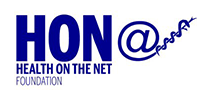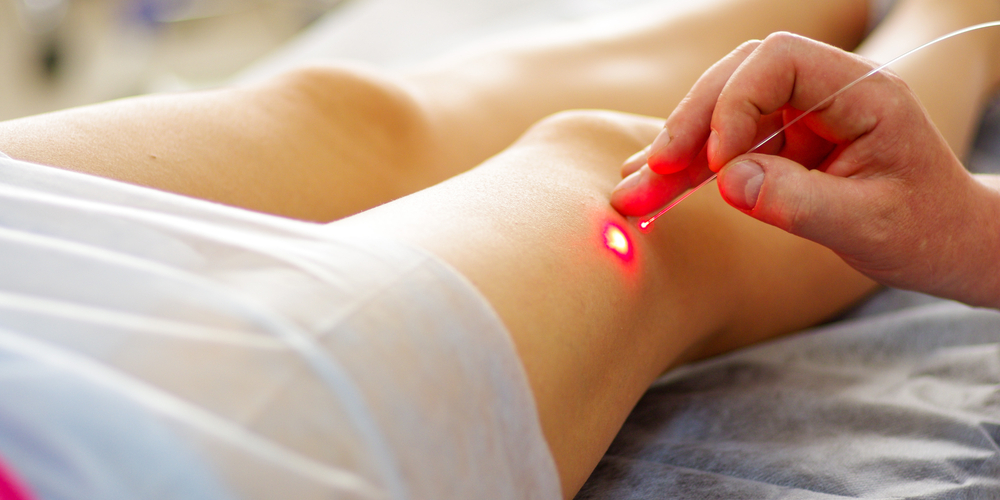
Vein Laser Treatments
Vein Laser treatments are a safe and effective method of treating both varicose veins and spider veins of the legs. Austin Vein Specialists is a leading expert in the most effective vein laser therapies available. We provide vein treatments for both cosmetic reasons as well as a medical necessity. Vein lasers can be used to treat more serious venous conditions such as venous reflux disease and symptomatic varicose veins that are leading to pain, swelling, blood clots, or skin damage. Vein laser treatments are also frequently utilized for the treatment of more minor cosmetic issues, such as spider veins or skin veins/capillaries of the legs, ankles, feet, and face. Vein Laser therapy can be utilized for veins on almost any part of the body.
One of the benefits of vein laser treatments is that they are a safe, fast, and effective method of removing both varicose veins and spider veins. Lasers have been utilized in the medical field for over 30 years, with significant refinements in vein lasers over the past decade.
Vein laser treatments utilize a focused beam of light to deliver thermal energy to the veins to make the leg veins close and disappear. The wavelength of the laser beam is directed at the pigment within red blood cells or the water content within the blood, therefore precisely targeting the abnormal veins that are pooling blood. This focused heat energy is able to close defective veins without significant risk of damaging the skin or adjacent structures. When the laser heat is delivered to the vein wall and the blood, the blood coagulates, and the vein wall collapses and closes. Depending on the size of the treated veins, the veins will then absorb and disappear over a period of days, weeks, or months.
Advantages of Vein Laser Treatments
There are many advantages of vein laser treatments over other types of vein therapies. One major advantage is that it allows patients with varicose veins to avoid traditional surgery, such as vein stripping or vein phlebectomy. Without the need for incisions or surgery, there is very little discomfort and minimal recovery time after.
Another advantage to vein lasers is that they can be utilized for many different locations of the body, even on the face and the ankles/feet. Other types of vein therapies, including sclerotherapy injections for vein, are not advised for treatment of thinned skin locations such as the face, hands, ankles, and feet. But laser therapy can be utilized safely in these locations.
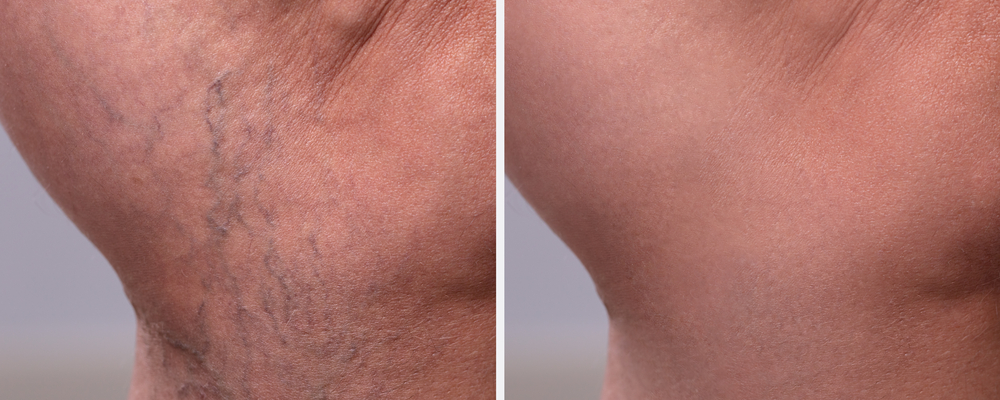
Another advantage of vein laser treatments is that they do not require medications or drugs to be delivered into the body. Other vein therapies, such as sclerotherapy, require medications to be injected into the veins to close them. Vein laser treatments use a more natural method of thermal heating of the veins.
An additional benefit of thermal therapy is that it can be used on almost any skin color/skin tone safely, as long as the right device and settings are chosen. Lastly, vein lasers do not require the use of needle punctures in the skin. For individuals who have a phobia or fear of needles or injections, then laser may be a good option.
Types of Vein Lasers
There are many types of vein lasers available. There are different types of lasers used for varicose veins than for spider veins. The varicose vein laser treatments use a laser that is often referred to generically as an EVLT laser. More accurately, the varicose vein laser is a diode laser, CW, class IV. Commonly used varicose vein diode lasers include the AngioDynamcics VenaCure 1470 nm laser (the preferred varicose vein laser at Austin Vein Specialists) or the Delta 810 nm diode laser. The Venacure laser is a water-specific laser, targeting water as the
chromophore to absorb the laser energy. This results in less pain and bruising with treatments, leading to a higher patient satisfaction rate. This vein treatment laser is able to target the varicose veins and the underlying venous insufficiency that is causing the varicose veins to develop, thereby minimizing the chance of recurrent varicose veins in the future.
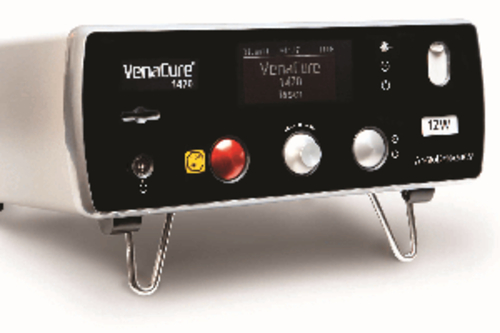

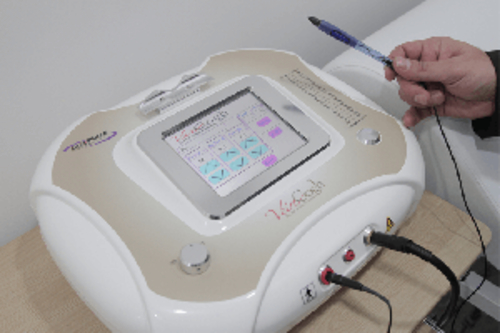
Spider vein laser treatments can also utilize a diode laser, but a diode laser with a different wavelength. A common diode laser utilized for spider veins is a 940 nm wavelength laser, such as the Dornier FlexiPulse laser. This wavelength more precisely targets spider veins. Other commonly utilized spider vein lasers are the YAG laser and the pulsed dye laser. The Vbeam Perfecta laser is a commonly used pulses dye laser for spider vein therapy.
Other common devices that are used to treat spider veins cosmetically include the IPL devices (Intense Pulse Light) and the Ohmic Thermolysis Devices. The Veinwave and VeinGogh devices are popular Ohmic Thermolysis Devices for treating spider veins. Choosing which device to utilize to treat your veins is best determined by a Vein Specialist, and will often depend on the location of the veins, the size of the veins, how many veins there are, and your skin color/tone.
What to Expect with Vein Laser Treatments
There will be some discomfort of the skin during the treatments as heat energy is delivered to the skin. This can be minimized using several techniques. One method to relieve treatment discomfort is to cool the skin or ice the skin before and during the vein laser treatments. Another option is to place a numbing cream or lotion on the skin prior to the treatment, such as Lidocaine cream or Emla cream. Your doctor will discuss these options with you prior to your treatment.
After the treatment has been completed, it is very common to have some temporary discoloration of the skin that may last for a few days to a few weeks. This can include redness of the skin, skin bruising, a slight tan discoloration of the skin, or “catch scratch” appearances of the veins themselves. In addition, the skin may be puffy or swollen for up to a few days. Final treatment results should be noticeable within a few weeks in most individuals.
If you undergo treatment on your legs, our vein specialists may recommend that you wear compression stockings for a period of a week or two after your treatment. This is to improve the cosmetic results of the therapy and to diminish the risk of complications.
How Many Vein Laser Treatments Will Be Necessary?
That can only be answered after an examination by your doctor. When utilizing an EVLT laser for varicose veins, often only one laser treatment is needed. When treating spider veins, several treatments are often necessary. The same area of the skin is usually not treated for 4-6 weeks to allow the veins to respond and the skin to have a chance to heal. Untreated areas of the skin can be treated quickly after the initial session (for example if one leg is treated on the first session, then the other leg could be treated the next day). The more numerous the veins and the darker the color of the veins, the more treatments will be necessary to achieve the desired results.
What to Avoid Around the Time of Vein Laser Treatments
Before your treatments, you should avoid iron supplements, certain antibiotics, and aspirin products, as these may cause unwanted reactions in the skin. Our vein specialist will review any other medications that you are taking prior to the treatment to determine if they could potentially interfere with the vein laser treatment. On the day of treatment, you should avoid using spray tans, lotions, creams, makeup, and moisturizers on the skin. These products may interfere with the laser penetration of the skin.
What Are Some Potential Downsides to Vein Laser Treatment?
There is never a “perfect” vein therapy, and there will always be some disadvantages of any therapy. One potential disadvantage of vein laser treatments over other vein therapies is that several treatments may be required to get the desired results. Since each individual treatment has a cost associated with it, laser treatments can sometimes be a more costly alternative to other forms of vein therapy.
Another potential disadvantage of vein laser treatments is that there is that they can be rather uncomfortable. Just like laser hair removal, vein laser therapy can be associated with some discomfort to get the desired results. Another potential disadvantage of vein laser treatments is that they can be rather time-consuming to complete. When you have a large number of spider veins on your legs, it often can be much quicker to perform sclerotherapy (and therefore sclerotherapy can often be more cost-effective).
Lastly, vein laser treatment cannot be utilized for larger skin veins such as reticular veins. Laser therapy typically cannot deliver enough heat to a reticular vein to close it without risking thermal burns to the skin. Since people often desire a treatment modality that can treat all of their skin veins simultaneously, if an individual has larger skin veins (reticular veins) that cannot be treated with lasers, then another treatment option may be better. In this scenario, sclerotherapy is often a better option.
If you would like to speak with our vein specialist about vein laser treatments in Austin or Round Rock, TX, please call (512) 220-5401. Call us for an initial no-obligation consultation with our physician


